Transmitting "hidden" radio signal
It will be about ways to hide the radio signal from an outsider "observer".
Or rather, about ways to reduce the probability of detecting a signal.
No math. Theory and practice on the fingers.
')
If signal parameters are unknown, then the only way to detect it is by energy.
The most obvious solution to the “power hiding” of the signal: we limit the transmitter power so that the interlocutor's receiver receives the signal at a sufficient level (the probability of error is equal to the maximum allowable).
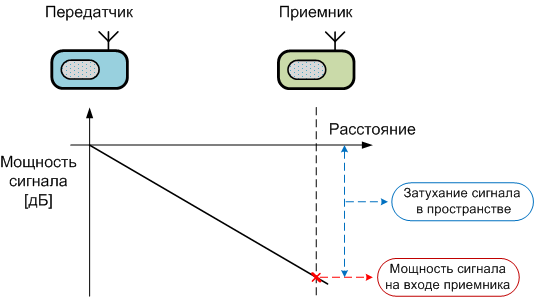
All who are beyond the "certain distance" signal to detect "can not" (more precisely, the probability of detection will be quite small).

Zones can be roughly divided into three parts with respect to the signal:
1 - Accepted
2 - Detectable
3 - We do not see
Detection is very simple, it is enough to analyze the spectrum of the frequency range.

Screenshot from SDRSharp program.
At a frequency of 939 MHz, the GSM signal spectrum is allocated. At a frequency of 939.8 MHz, there is also a GSM signal, but its level is about 20 dB lower. There are probably signals on other frequencies, but the transmitters are far enough away from the receiver so that they cannot be detected.
This is called energy detection.
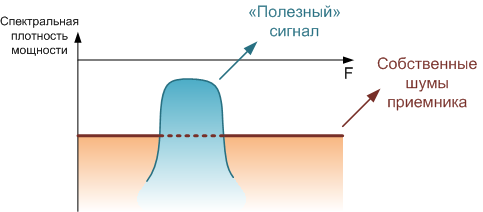
We will consider such pictures here - “flies” separately, “cutlets” separately.
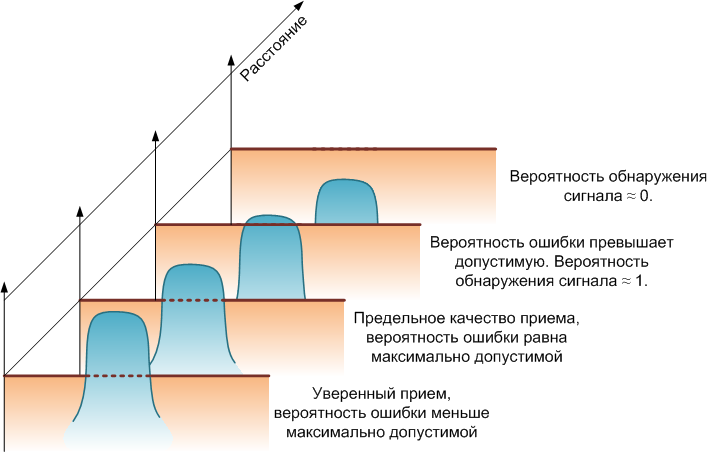
It should also be noted that if the spectrum of the signal is depicted below the noise level, this does not mean that it is “completely invisible”. In its place is visible the sum of the signal and noise spectra, and, for example, if the signal level is 10 dB below the noise level, then the total signal should be 0.41 dB higher. If a third-party observer decides to average the spectral density over time, then the resolution of the signal power density will gradually increase, and with it the probability of detection will increase.
Power limitation is, of course, not the way to talk about.
It is worth noting that the signal power can be estimated from the area of its spectrum. And if we want to save the signal power and reduce the probability of detection, then we will have to expand its spectrum.
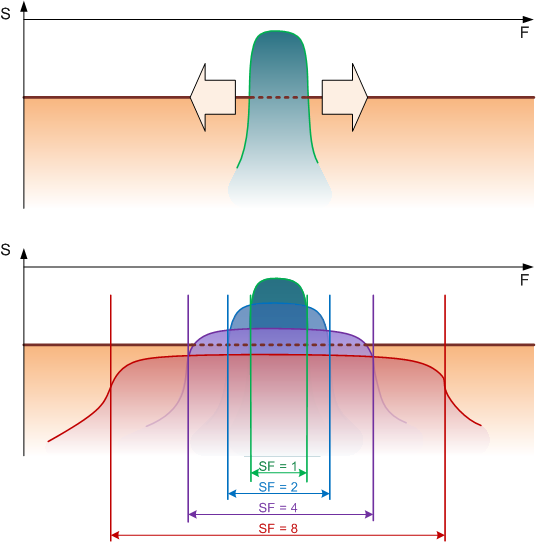
The figure shows the spectrum of the spread spectrum signal. There are several ways to expand the spectrum. You can evenly move the signal over the frequency range, and when averaged over time we will see a wide, uniform spectrum. This method is called FHSS (Frequency Hopping Spread Spectrum) and it is used, for example, in Bluetooth (where it is used, of course, for other purposes, but the essence is the same).
Initially, the width of the spectrum depends on the rate of change of the signal (the rate of change of characters). For example, if we modulate the phase of a signal depending on the information flow, then the faster the phase change occurs, the more broadband the signal turns out. From here we come to another extension method - DSSS (Direct Sequence Spread Spectrum). During transmission, each bit is replaced by a pseudo-random binary sequence (as an option) (pseudo-randomness is needed to evenly distribute the signal power over the frequency range).
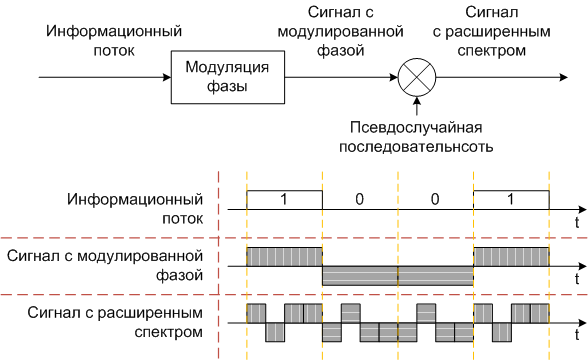
The length of the sequence is directly proportional to the spreading factor.
The receiver should use a correlator, which will calculate the correlation of the received signal and the reference sequence, and decide on the transmitted symbol.
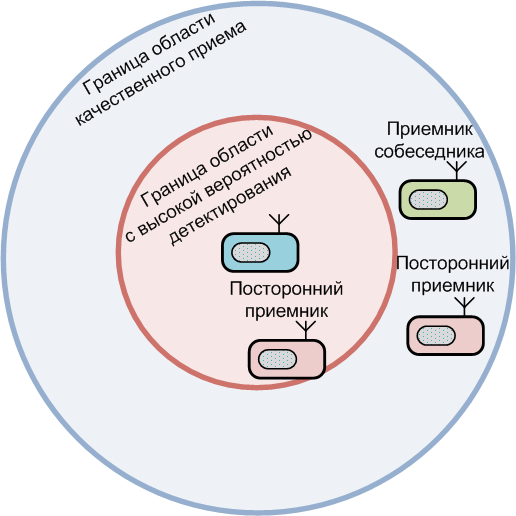
As a result of the application, the distance at which the quality connection is ensured remains the same, and the region with a high probability of signal detection decreases.
DSSS is used in GPS, 802.11b, CDMA multiple access technology standards.
In addition to a simple energy reduction using DSSS, you can “hide” the signal, for example, in the spectrum of a television signal, and then restore it by correlation processing.
Another way to reduce the probability of detecting a signal is to use an antenna array, i.e. antennas with a set of radiating elements.
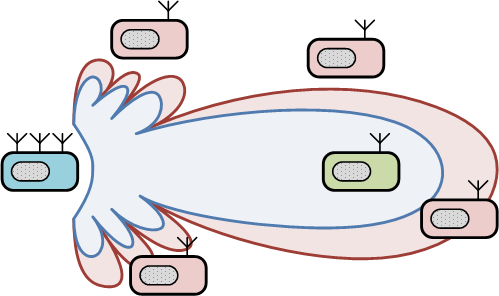
Using an antenna array, one can form a radiation pattern, i.e. emit the signal only towards the receiver.
As a result, energy is saved. As a limitation, direct visibility between the receiver and the transmitter is required.
Another way to call MU-MIMO technology, which is used in the standard 802.11ac.

Several antenna elements form the signal in such a way that the interlocutor's zone has the maximum signal level in the interlocutor's receiver zone and the minimum in the zone of other receivers. (And using the MU-MIMO technology, the access point forms such patterns for each of the users and transmits their sum simultaneously, in one frequency band.)
But:
Such options can offer radio engineering. There are other ways of hiding the signal (all sorts of chaotic systems), and other ways of spreading the spectrum (for example, instead of DSSS (or in addition to it) you can use noise-resistant coding (LDPC or turbo code), which gives a gain in frequency range utilization efficiency) but I think that the rest is already particular, and that's enough for now.
If you have questions, comments or recommendations you are welcome.
Or rather, about ways to reduce the probability of detecting a signal.
No math. Theory and practice on the fingers.
')
If signal parameters are unknown, then the only way to detect it is by energy.
The most obvious solution to the “power hiding” of the signal: we limit the transmitter power so that the interlocutor's receiver receives the signal at a sufficient level (the probability of error is equal to the maximum allowable).

All who are beyond the "certain distance" signal to detect "can not" (more precisely, the probability of detection will be quite small).
"A certain distance"
This “specific distance” mentioned in the absence of external interfering signals (interference) depends on the quality of the equipment used. The main indicator of receiver quality is its sensitivity. She just tells us how weak the signal can be received with the permissible probability of bit error.
In most cases, the limit is determined by the receiver's own noise power. Everything makes noise, starting from resistors (the noise is caused by the chaotic thermal movement of electrons), ending with amplifiers (shot noise, thermal noise, distribution and resistance noise) and antenna (generally a separate topic).
If the topic is interesting, you can look at the following methodological guide:
Melikhov S.V. Evaluation of the sensitivity of radio receivers: Teaching manual. - Tomsk: TUSUR, 2012. - 100 p.
In most cases, the limit is determined by the receiver's own noise power. Everything makes noise, starting from resistors (the noise is caused by the chaotic thermal movement of electrons), ending with amplifiers (shot noise, thermal noise, distribution and resistance noise) and antenna (generally a separate topic).
If the topic is interesting, you can look at the following methodological guide:
Melikhov S.V. Evaluation of the sensitivity of radio receivers: Teaching manual. - Tomsk: TUSUR, 2012. - 100 p.

Zones can be roughly divided into three parts with respect to the signal:
1 - Accepted
2 - Detectable
3 - We do not see
Detection is very simple, it is enough to analyze the spectrum of the frequency range.

Screenshot from SDRSharp program.
At a frequency of 939 MHz, the GSM signal spectrum is allocated. At a frequency of 939.8 MHz, there is also a GSM signal, but its level is about 20 dB lower. There are probably signals on other frequencies, but the transmitters are far enough away from the receiver so that they cannot be detected.
This is called energy detection.

We will consider such pictures here - “flies” separately, “cutlets” separately.

It should also be noted that if the spectrum of the signal is depicted below the noise level, this does not mean that it is “completely invisible”. In its place is visible the sum of the signal and noise spectra, and, for example, if the signal level is 10 dB below the noise level, then the total signal should be 0.41 dB higher. If a third-party observer decides to average the spectral density over time, then the resolution of the signal power density will gradually increase, and with it the probability of detection will increase.
Power limitation is, of course, not the way to talk about.
It is worth noting that the signal power can be estimated from the area of its spectrum. And if we want to save the signal power and reduce the probability of detection, then we will have to expand its spectrum.

The figure shows the spectrum of the spread spectrum signal. There are several ways to expand the spectrum. You can evenly move the signal over the frequency range, and when averaged over time we will see a wide, uniform spectrum. This method is called FHSS (Frequency Hopping Spread Spectrum) and it is used, for example, in Bluetooth (where it is used, of course, for other purposes, but the essence is the same).
Initially, the width of the spectrum depends on the rate of change of the signal (the rate of change of characters). For example, if we modulate the phase of a signal depending on the information flow, then the faster the phase change occurs, the more broadband the signal turns out. From here we come to another extension method - DSSS (Direct Sequence Spread Spectrum). During transmission, each bit is replaced by a pseudo-random binary sequence (as an option) (pseudo-randomness is needed to evenly distribute the signal power over the frequency range).

The length of the sequence is directly proportional to the spreading factor.
The receiver should use a correlator, which will calculate the correlation of the received signal and the reference sequence, and decide on the transmitted symbol.

As a result of the application, the distance at which the quality connection is ensured remains the same, and the region with a high probability of signal detection decreases.
DSSS is used in GPS, 802.11b, CDMA multiple access technology standards.
In addition to a simple energy reduction using DSSS, you can “hide” the signal, for example, in the spectrum of a television signal, and then restore it by correlation processing.
Another way to reduce the probability of detecting a signal is to use an antenna array, i.e. antennas with a set of radiating elements.

Using an antenna array, one can form a radiation pattern, i.e. emit the signal only towards the receiver.
As a result, energy is saved. As a limitation, direct visibility between the receiver and the transmitter is required.
Another way to call MU-MIMO technology, which is used in the standard 802.11ac.

Several antenna elements form the signal in such a way that the interlocutor's zone has the maximum signal level in the interlocutor's receiver zone and the minimum in the zone of other receivers. (And using the MU-MIMO technology, the access point forms such patterns for each of the users and transmits their sum simultaneously, in one frequency band.)
But:
- The location of other receivers must be known (more precisely, the characteristics of the communication channel with other receivers are necessary).
- The more receivers taken into account, the greater must be the number of antenna elements.
On the positive side: no direct visibility required.
Conclusion
Such options can offer radio engineering. There are other ways of hiding the signal (all sorts of chaotic systems), and other ways of spreading the spectrum (for example, instead of DSSS (or in addition to it) you can use noise-resistant coding (LDPC or turbo code), which gives a gain in frequency range utilization efficiency) but I think that the rest is already particular, and that's enough for now.
If you have questions, comments or recommendations you are welcome.
Source: https://habr.com/ru/post/194058/
All Articles